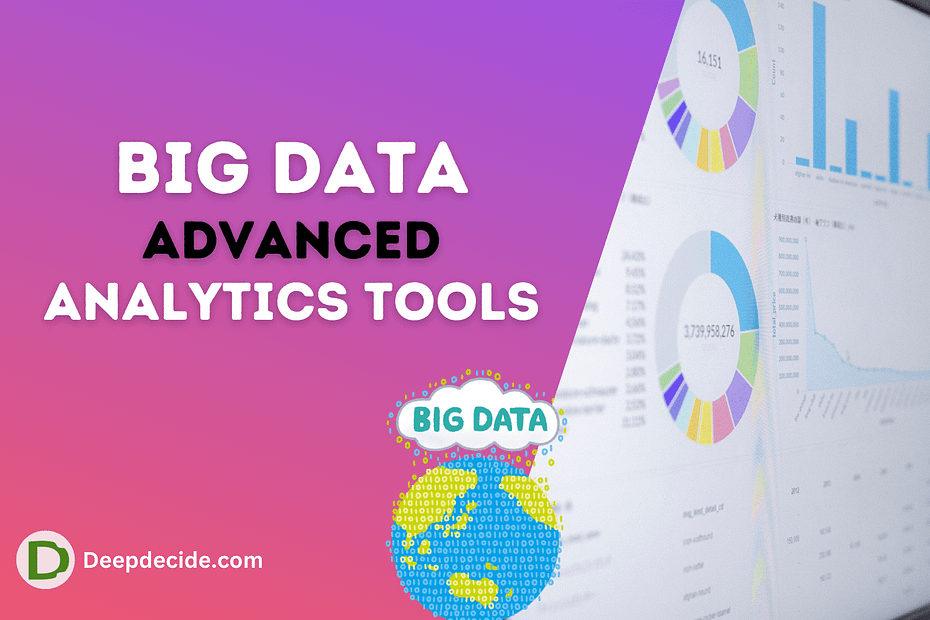Last Updated on: 31st March 2024, 11:49 pm
In today’s digital age, data has become the lifeblood of modern enterprises. The ability to harness and analyze vast amounts of data has transformed the way businesses operate, make decisions, and gain insights into their customers, operations, and market trends.
Big data analytics tools have emerged as powerful instruments in this landscape, enabling organizations to extract valuable insights, make informed decisions, and drive innovation. Let’s delve into the world of big data analytics tools, exploring their features, capabilities, and how they contribute to business success.
Understanding Big Data Analytics Tools
Big data analytics tools encompass a wide range of software solutions designed to process, analyze, and visualize large and complex datasets.
These tools leverage advanced algorithms, machine learning techniques, and data processing capabilities to uncover hidden patterns, correlations, and trends within the data.
They play a crucial role in various industries such as finance, healthcare, retail, manufacturing, and more, helping organizations gain competitive advantages, improve operational efficiency, and enhance decision-making processes.
Read also: SQL Subqueries: Queries within Queries
15 Big Data Analytics Tools and Their Features
Big data analytics tools have emerged as essential assets, enabling organizations to extract valuable insights, drive informed decision-making, and gain a competitive edge. Let’s delve into the most popular big data analytics tools and explore their features, benefits, and contributions to modern data analytics.
1. APACHE Hadoop
APACHE Hadoop stands as a cornerstone in big data processing and storage. Leveraging a Java-based open-source architecture, Hadoop facilitates efficient parallel processing through its cluster system. Key features include:
- Cost-Efficiency: Businesses can leverage Hadoop’s free storage solution, making it an economical choice.
- Scalability: Hadoop seamlessly scales to handle large data volumes distributed in small chunks.
- Flexibility: It supports various data formats like MySQL and JSON, offering a highly adaptable environment.
2. Cassandra
APACHE Cassandra is a distributed database renowned for its scalability and performance. Key features include:
- High Availability: Cassandra ensures data availability with minimal downtime, which is critical for mission-critical applications.
- Versatility: It supports structured, semi-structured, and unstructured data, offering flexibility in data management.
- Replication and Fault Tolerance: Data replication and automatic node replacement enhance system reliability and resilience.
3. Qubole
Qubole is a cloud-based big data analytics platform known for its efficiency and reduced time-to-insights. Key features include:
- Predictive Analysis: Qubole empowers predictive modeling and analysis, aiding businesses in decision-making.
- Cost Optimization: It integrates with major cloud platforms, optimizing cloud computing costs by up to 50%.
- Real-time Insights: Users gain real-time visibility into system performance and analytics, enhancing operational agility.
4. Xplenty
Xplenty offers an intuitive data pipeline building experience with minimal coding. Key features include:
- ETL Solutions: Xplenty simplifies Extract, Transform, and Load (ETL) processes, streamlining data integration.
- Cross-Platform Deployment: It supports on-premises and cloud deployment, ensuring data accessibility.
- Security and Compliance: Xplenty adheres to industry standards with SSL/TSL encryption and robust authentication.
5. Spark
Apache Spark is a high-performance data processing engine ideal for big data analytics and machine learning. Key features include:
- Multi-language Support: Spark offers APIs in Java, Scala, Python, and R, catering to diverse developer preferences.
- Real-time Streaming: Spark Streaming enables real-time data processing, crucial for time-sensitive applications.
- Scalability: It handles multi-petabyte data sets efficiently, making it a preferred choice for large-scale analytics projects.
6. MongoDB
MongoDB is a NoSQL database known for its scalability and developer-friendly features. Key features include:
- Schema-less Design: MongoDB’s document-oriented structure allows flexible data modeling without predefined schemas.
- High Performance: It handles large volumes of unstructured data with ease, making it suitable for modern applications.
- Ease of Use: Developers can interact with MongoDB using popular programming languages like Python, JavaScript, and Ruby.
7. Apache Storm
Apache Storm is a real-time stream processing system ideal for distributed computing. Key features include:
- Real-time Processing: Storm processes data streams with minimal latency, which is crucial for time-sensitive applications.
- Scalability: It scales horizontally to handle large data volumes and high throughput requirements.
- Fault Tolerance: Storm ensures data processing continuity even in the event of node failures, enhancing system reliability.
8. SAS
SAS is a comprehensive analytics platform offering a range of tools for data analysis and visualization. Key features include:
- Statistical Analysis: SAS provides advanced statistical modeling capabilities for data-driven insights.
- Data Management: It offers data integration, cleansing, and transformation features for efficient data processing.
- Visual Analytics: SAS Visual Analytics enables interactive data exploration and visualization, aiding in decision-making.
9. Data Pine
Data Pine is a business intelligence tool specializing in data visualization and reporting. Key features include:
- Dashboards: Data Pine offers customizable dashboards for real-time data monitoring and analysis.
- Predictive Analytics: It supports predictive modeling and forecasting to anticipate trends and insights.
- User-Friendly Interface: Data Pine’s intuitive interface allows users to create reports and visualizations with ease.
10. Rapid Miner
Rapid Miner is an end-to-end data science platform offering a range of data analytics tools. Key features include:
- Workflow Automation: Rapid Miner automates data processing workflows, reducing manual effort.
- Machine Learning: It provides ML algorithms for predictive modeling, classification, and clustering.
- Deployment Options: Rapid Miner supports cloud and on-premises deployment for flexible usage.
11. Tableau Public
Tableau Public is a data visualization tool enabling users to create interactive charts and dashboards. Key features include:
- Visualizations: Tableau offers a wide range of interactive visualizations for data exploration and storytelling.
- Sharing and Collaboration: Users can share visualizations publicly and collaborate on data projects.
- Accessibility: Tableau Public is free to use, making it accessible to a wide audience for data analysis.
12. Integrate.io
Integrate.io is a data integration platform offering ETL solutions for data pipelines. Key features include:
Cloud Integration:** Integrate.io supports cloud-based data integration across multiple platforms.
- Automation: It automates data workflows, reducing manual intervention and improving efficiency.
- Scalability: Integrate.io scales to handle growing data volumes and diverse data sources.
13. Google Fusion Tables
Google Fusion Tables is a web service for data management, visualization, and collaboration. Key features include:
- Data Upload: Users can upload and merge data tables for analysis and visualization.
- Visualization Tools: It offers charting and mapping tools for creating interactive data visualizations.
- Collaboration: Google Fusion Tables allows users to share and collaborate on data projects in real-time.
14. Atlas.ti
Atlas.ti is a qualitative data analysis software offering tools for qualitative research and analysis. Key features include:
- Coding and Annotation: Atlas.ti supports text and multimedia data coding and annotation for in-depth analysis.
- Visualization: It provides visualizations and reports to interpret qualitative data and findings.
- Collaboration: Atlas.ti supports team collaboration and project management for research projects.
15. Power BI
Microsoft Power BI empowers organizations with:
- Interactive dashboards and real-time data visualizations.
- Data modeling and advanced analytics capabilities.
- Integration with Microsoft ecosystem and cloud services for seamless data processing.
Choosing the Right Big Data Analytics Tool
Selecting the appropriate big data analytics tool depends on several factors, such as data volume, complexity, processing requirements, budget, and specific use cases. Organizations should evaluate the scalability, performance, integration capabilities, and ease of use of each tool to align with their business objectives and analytical needs.
Benefits of Big Data Analytics Tools
Big data analytics tools offer numerous benefits to organizations:
- Actionable Insights: Uncover hidden patterns, trends, and correlations within data for informed decision-making.
- Operational Efficiency: Streamline data processing, analysis, and reporting workflows for improved efficiency.
- Scalability: Handle large volumes of data and scale resources based on demand.
- Predictive Analytics: Forecast future trends, behaviors, and outcomes using advanced modeling techniques.
- Competitive Advantage: Gain a competitive edge by leveraging data-driven insights for strategic initiatives and innovation.
Conclusion
In conclusion, big data analytics tools are instrumental in unlocking the full potential of data for businesses. By leveraging advanced technologies, algorithms, and processing capabilities, organizations can extract valuable insights, improve decision-making processes, and drive business growth. Understanding the features and capabilities of prominent big data analytics tools empowers organizations to make informed choices and derive maximum value from their data assets. As technology continues to evolve, embracing robust big data analytics solutions becomes essential for staying competitive and driving innovation in today’s data-driven world.
FAQs
- What are the benefits of big data analytics tools?
Big data analytics tools offer cost-effective storage, scalability, real-time insights, and predictive analysis capabilities, empowering businesses to make data-driven decisions. - Which industries benefit from big data analytics tools?
Industries like finance, healthcare, retail, manufacturing, and technology benefit significantly from big data analytics tools, optimizing operations and enhancing customer experiences. - How do big data analytics tools contribute to innovation?
By unlocking actionable insights and facilitating predictive modeling, big data analytics tools drive innovation, helping businesses develop new products, services, and strategies based on data-driven insights.



